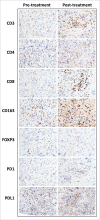Analysis of the immune infiltrate in undifferentiated pleomorphic sarcoma of the extremity and trunk in response to radiotherapy: Rationale for combination neoadjuvant immune checkpoint inhibition and radiotherapy
- PMID: 29308306
- PMCID: PMC5749668
- DOI: 10.1080/2162402X.2017.1385689
Analysis of the immune infiltrate in undifferentiated pleomorphic sarcoma of the extremity and trunk in response to radiotherapy: Rationale for combination neoadjuvant immune checkpoint inhibition and radiotherapy
Abstract
Background: Undifferentiated pleomorphic sarcoma of the extremity and trunk (ET-UPS) presents a unique therapeutic challenge. Although immunotherapy has recently been employed in advanced soft tissue sarcoma, there is limited data characterizing the immune infiltrate in ET-UPS. Radiotherapy (RT) has been shown in other tumor types to promote tumor antigen release and enhance tumor-specific targeting by the adaptive immune system. The aim of this study was to 1) characterize the baseline immune infiltrate and 2) evaluate the effect of preoperative RT on the histologic appearance of and the immune infiltrate in ET-UPS. Methods: We identified 17 matched ET-UPS samples before and after RT. Immunohistochemistry was performed with CD8, CD4, PD-L1, PD1, CD3, CD163 and FoxP3 positive cells identified in all samples. Changes in the immune infiltrate following RT were examined. Results: There was a trend towards increased density of tumor infiltrating immune cells in ET-UPS following RT, with increases in median number of CD3 (158 vs 219 cells/mm2, p = 0.06), CD4 (3 vs 13 cells/mm2, p = 0.01), CD8 (55 vs 111 cells/mm2, p = 0.17), and FOXP3 (14 vs 25 cells/mm2, p = 0.23) positive cells. Interestingly, although PD-L1 was not expressed in any ET-UPS tumor at baseline, positive PD-L1 expression was observed in 21% (3/14) of tumors after RT (p = 0.07). Conclusion: An immune infiltrate is present in ET-UPS at the time of diagnosis, with a trend towards increased density of immune infiltrate and PD-L1 expression after RT. These data support prospectively evaluating immune checkpoint inhibitors with standard of care RT in the treatment of ET-UPS.
Keywords: extremity sarcoma; immune check point; immunotherapy; radiation therapy; undifferentiated pleomorphic sarcoma.
Figures




Similar articles
-
Phase II study of neoadjuvant checkpoint blockade in patients with surgically resectable undifferentiated pleomorphic sarcoma and dedifferentiated liposarcoma.BMC Cancer. 2018 Sep 24;18(1):913. doi: 10.1186/s12885-018-4829-0. BMC Cancer. 2018. PMID: 30249211 Free PMC article. Clinical Trial.
-
The immune landscape of undifferentiated pleomorphic sarcoma.Front Oncol. 2022 Oct 12;12:1008484. doi: 10.3389/fonc.2022.1008484. eCollection 2022. Front Oncol. 2022. PMID: 36313661 Free PMC article.
-
Osteosarcoma and soft-tissue sarcomas with an immune infiltrate express PD-L1: relation to clinical outcome and Th1 pathway activation.Oncoimmunology. 2020 Mar 18;9(1):1737385. doi: 10.1080/2162402X.2020.1737385. Oncoimmunology. 2020. PMID: 33457085 Free PMC article.
-
A systematic review of undifferentiated pleomorphic sarcoma of the chest wall.Chin Clin Oncol. 2023 Dec;12(6):66. doi: 10.21037/cco-23-71. Epub 2023 Nov 28. Chin Clin Oncol. 2023. PMID: 38073309
-
Immune checkpoint inhibitors in treatment of soft-tissue sarcoma: A systematic review and meta-analysis.Eur J Cancer. 2021 Jul;152:165-182. doi: 10.1016/j.ejca.2021.04.034. Epub 2021 Jun 6. Eur J Cancer. 2021. PMID: 34107450
Cited by
-
Changes in the tumor immune microenvironment in resected recurrent soft tissue sarcomas.Ann Transl Med. 2019 Aug;7(16):387. doi: 10.21037/atm.2019.07.43. Ann Transl Med. 2019. PMID: 31555701 Free PMC article.
-
Radiation Therapy Combined With Checkpoint Blockade Immunotherapy for Metastatic Undifferentiated Pleomorphic Sarcoma of the Maxillary Sinus With a Complete Response.Front Oncol. 2018 Oct 17;8:435. doi: 10.3389/fonc.2018.00435. eCollection 2018. Front Oncol. 2018. PMID: 30386736 Free PMC article.
-
Phase II study of neoadjuvant checkpoint blockade in patients with surgically resectable undifferentiated pleomorphic sarcoma and dedifferentiated liposarcoma.BMC Cancer. 2018 Sep 24;18(1):913. doi: 10.1186/s12885-018-4829-0. BMC Cancer. 2018. PMID: 30249211 Free PMC article. Clinical Trial.
-
Novel Insights into the Immunotherapy of Soft Tissue Sarcomas: Do We Need a Change of Perspective?Biomedicines. 2021 Aug 1;9(8):935. doi: 10.3390/biomedicines9080935. Biomedicines. 2021. PMID: 34440139 Free PMC article. Review.
-
The immune landscape of undifferentiated pleomorphic sarcoma.Front Oncol. 2022 Oct 12;12:1008484. doi: 10.3389/fonc.2022.1008484. eCollection 2022. Front Oncol. 2022. PMID: 36313661 Free PMC article.
References
-
- Brahmer J, Reckamp KL, Baas P, Crinò L, Eberhardt WE, Poddubskaya E, Antonia S, Pluzanski A, Vokes EE, Holgado E, et al.. Nivolumab versus Docetaxel in Advanced Squamous-Cell Non-Small-Cell Lung Cancer. N Engl J Med. 2015;373(2):123–135. doi:10.1056/NEJMoa1504627. PMID:26028407. - DOI - PMC - PubMed
-
- Topalian SL, Hodi FS, Brahmer JR, Gettinger SN, Smith DC, McDermott DF, Powderly JD, Carvajal RD, Sosman JA, Atkins MB, et al.. Safety, activity, and immune correlates of anti-PD-1 antibody in cancer. N Engl J Med. 2012;366(26):2443–2454. doi:10.1056/NEJMoa1200690. PMID:22658127. - DOI - PMC - PubMed
Publication types
Grants and funding
LinkOut - more resources
Full Text Sources
Other Literature Sources
Research Materials
